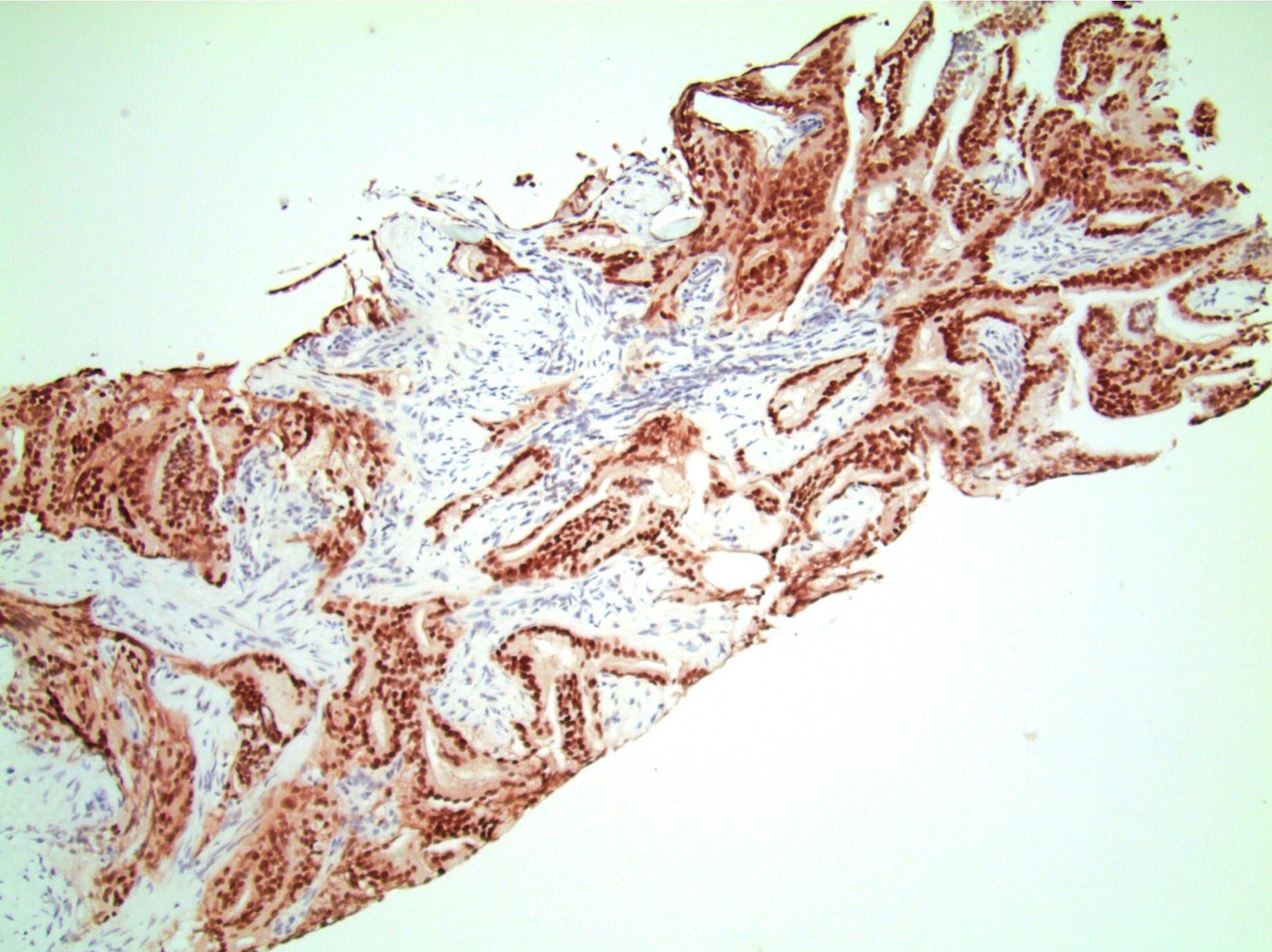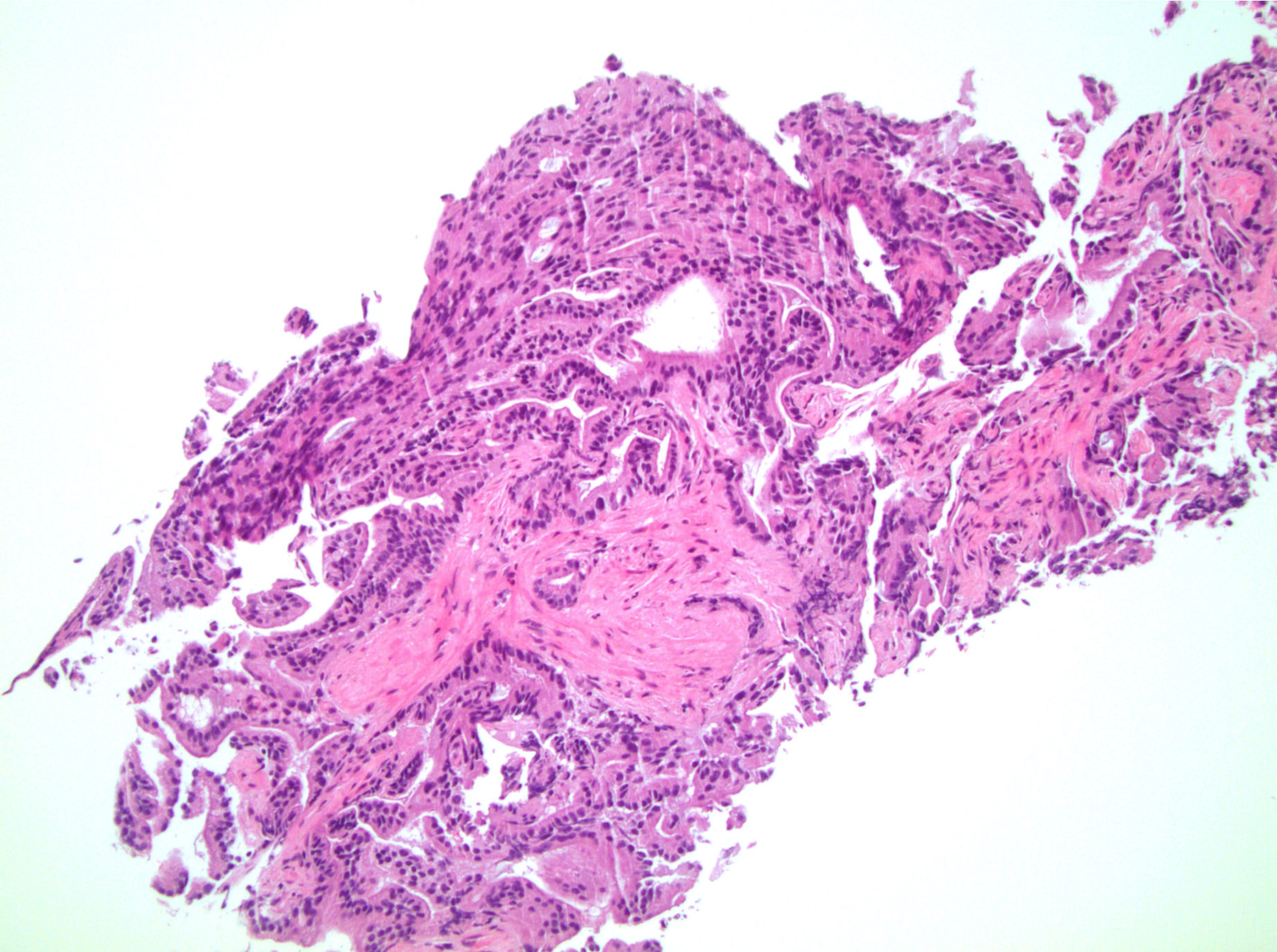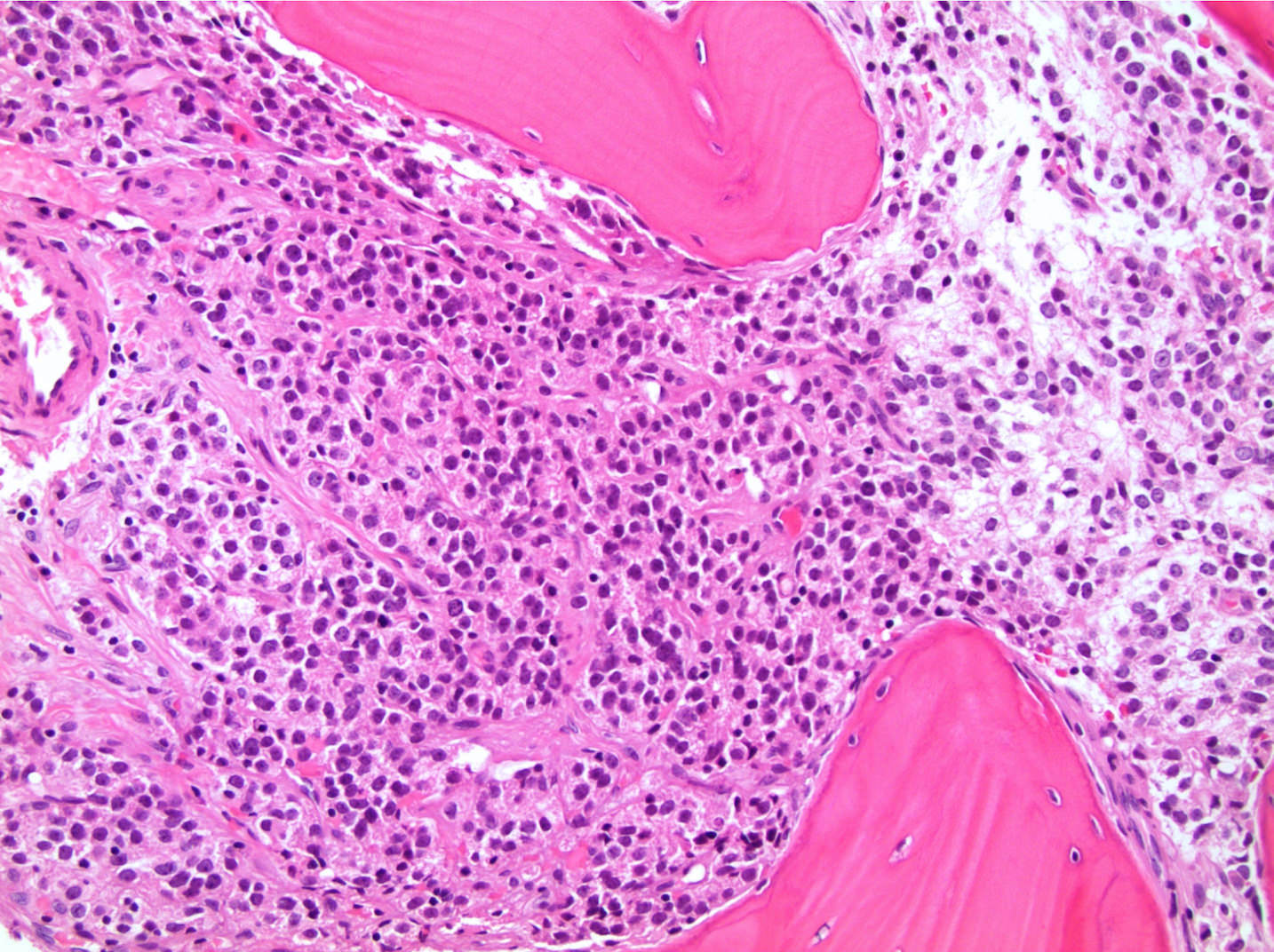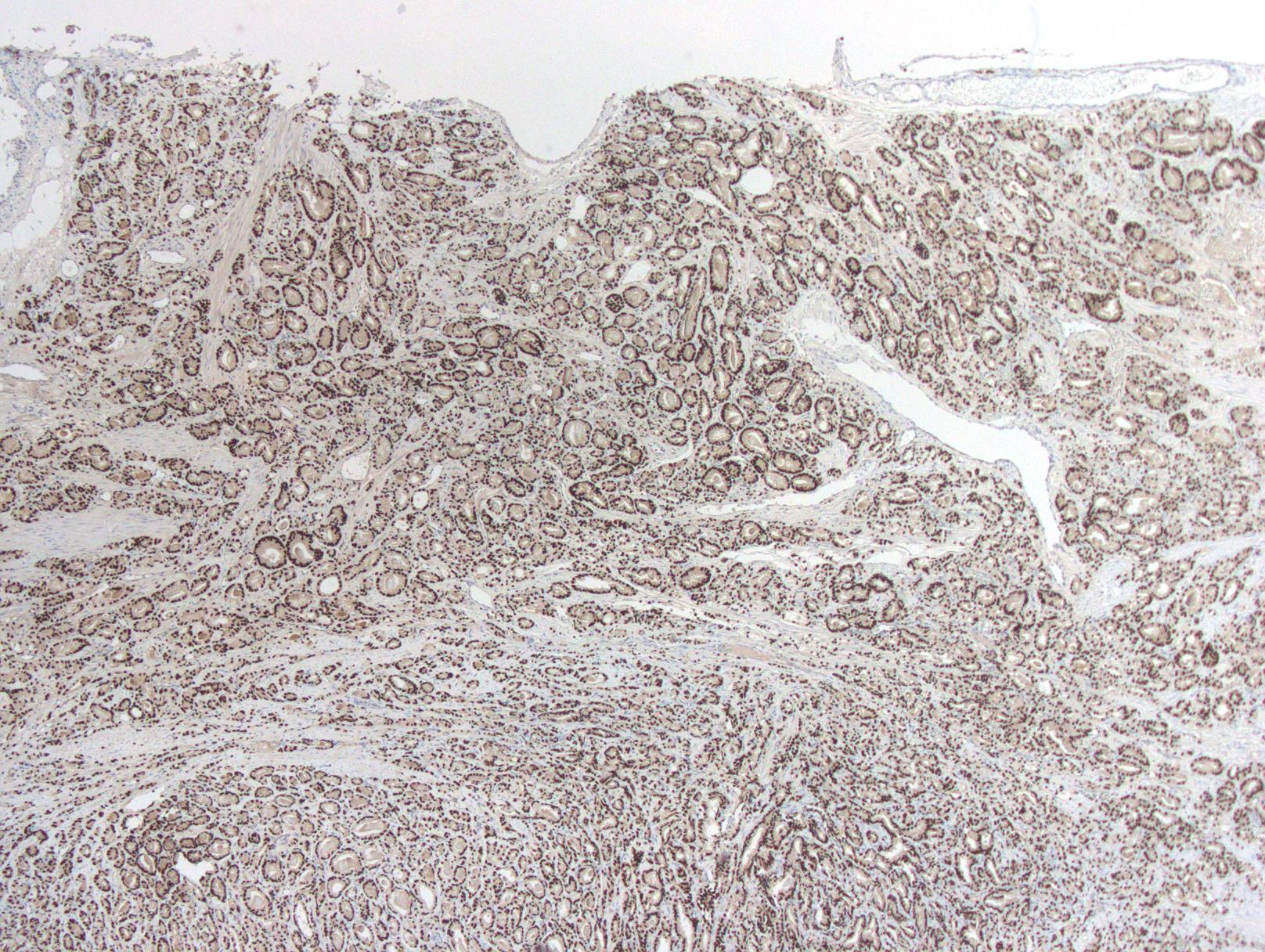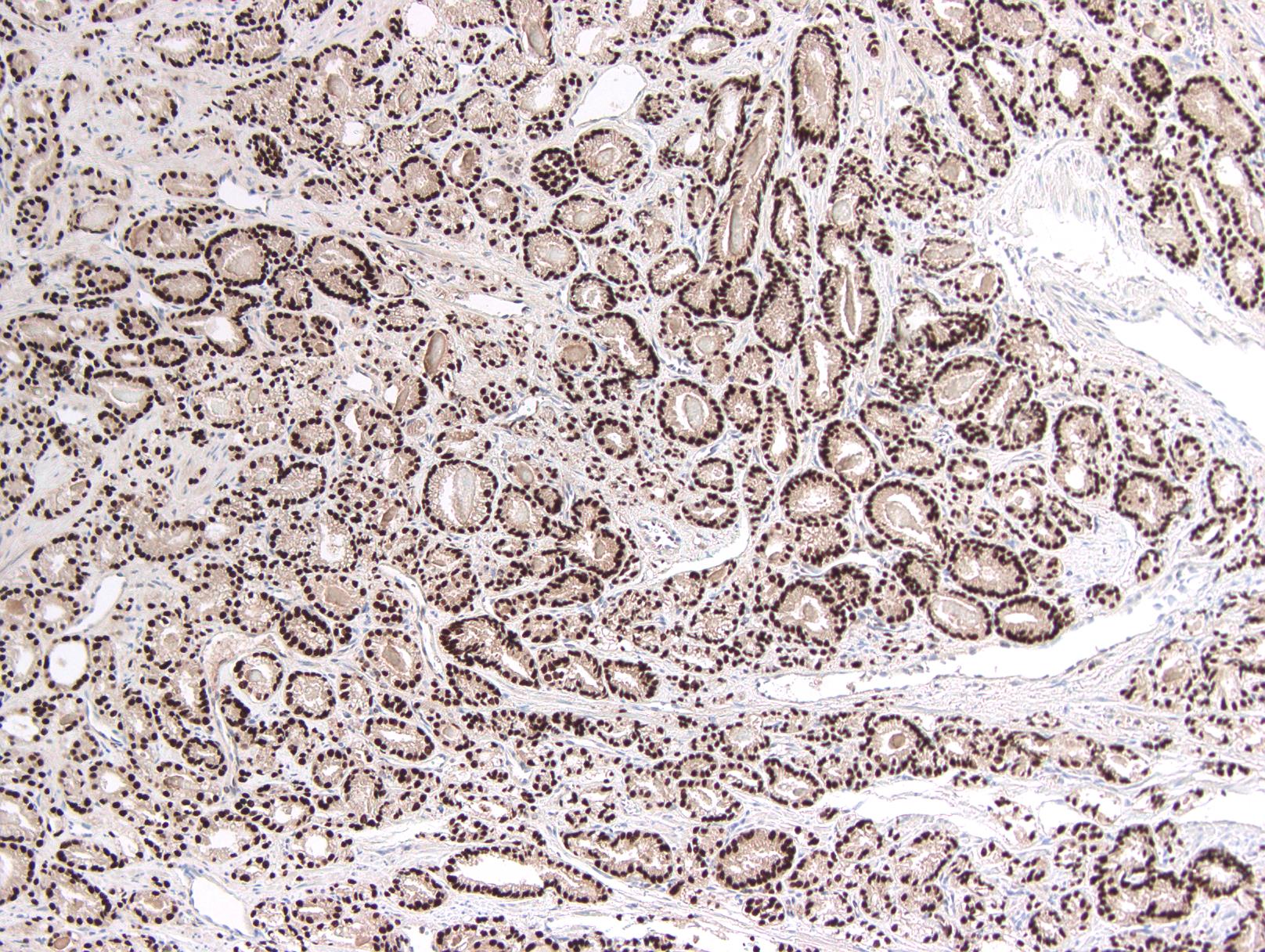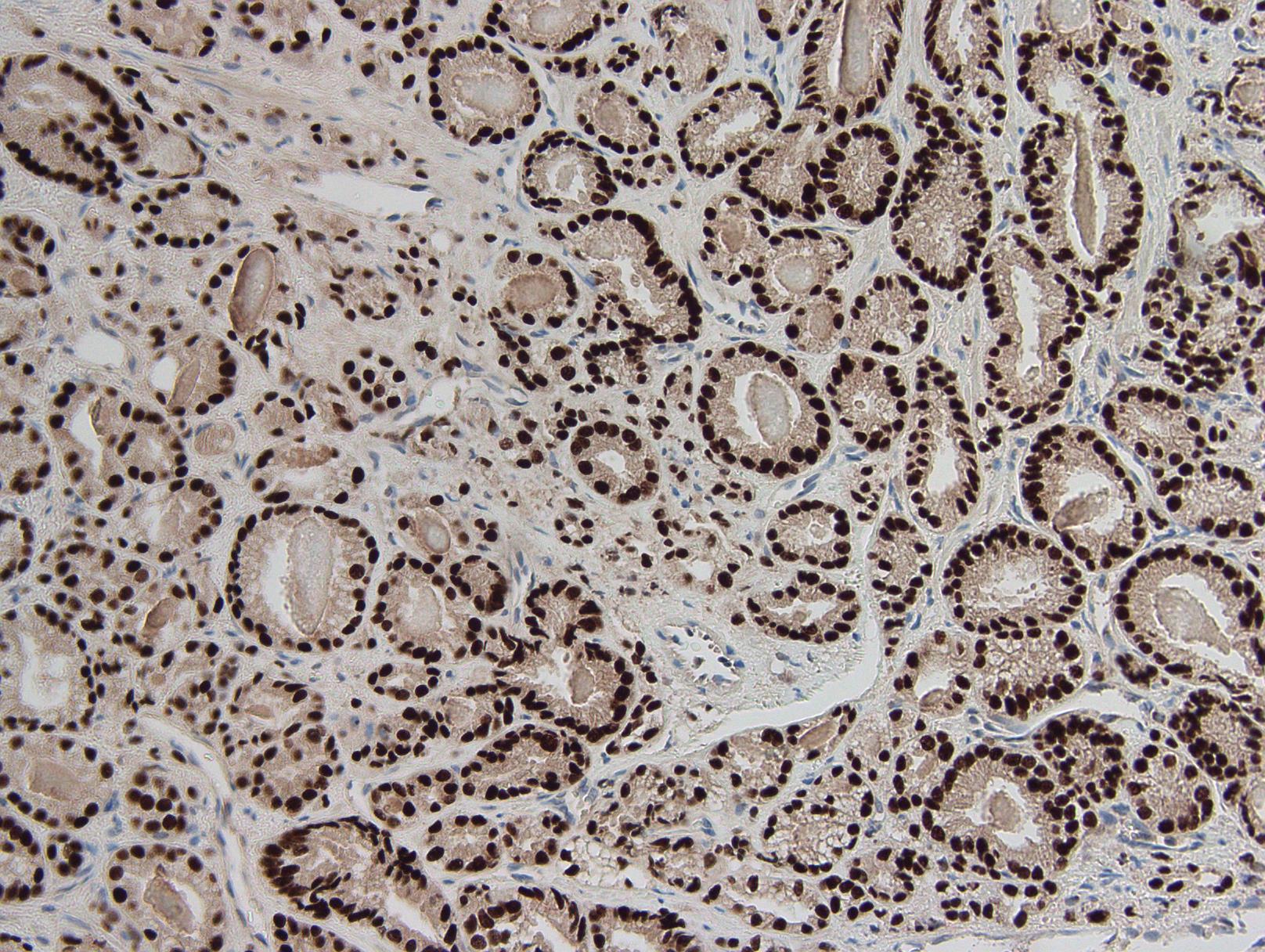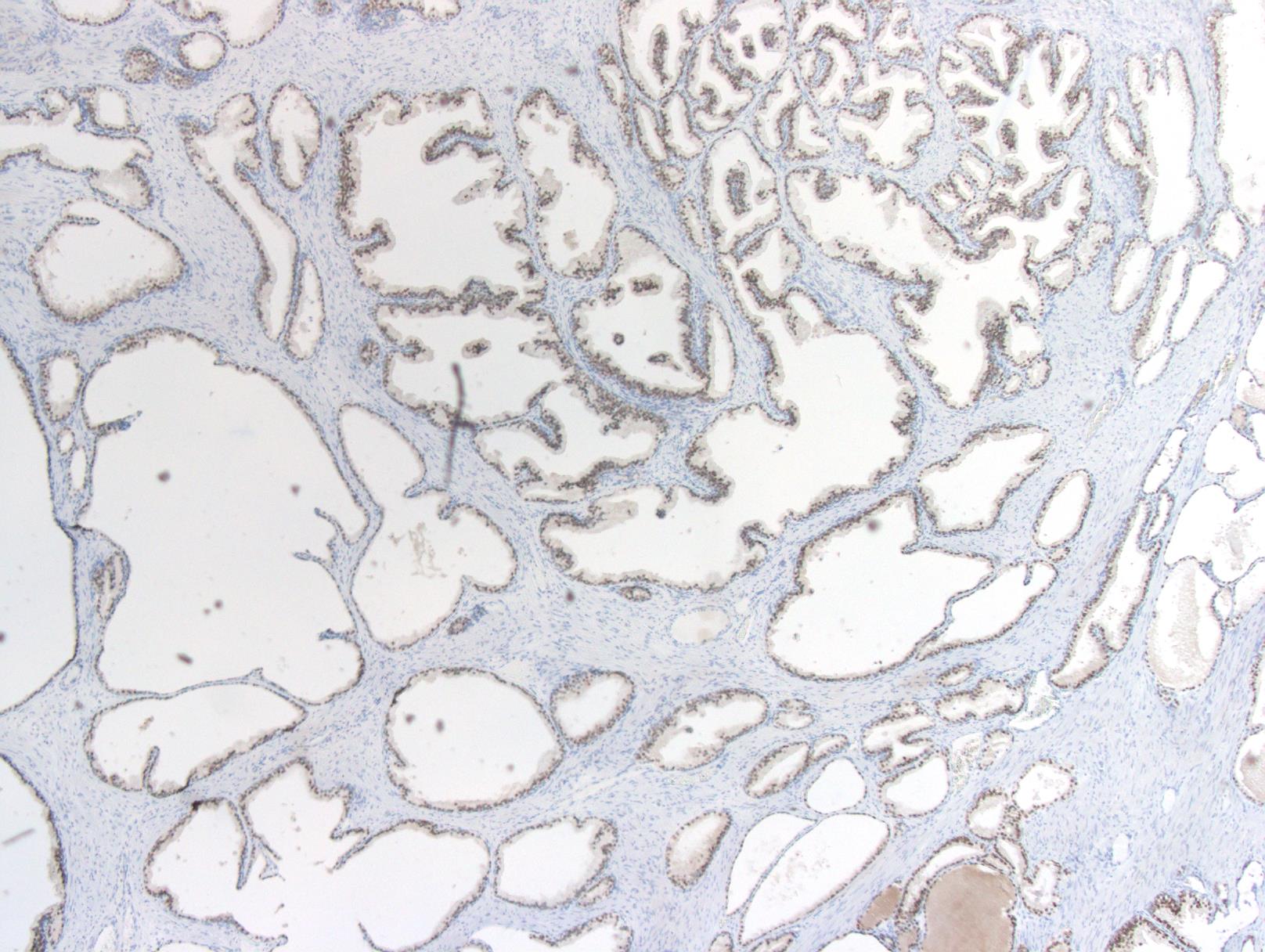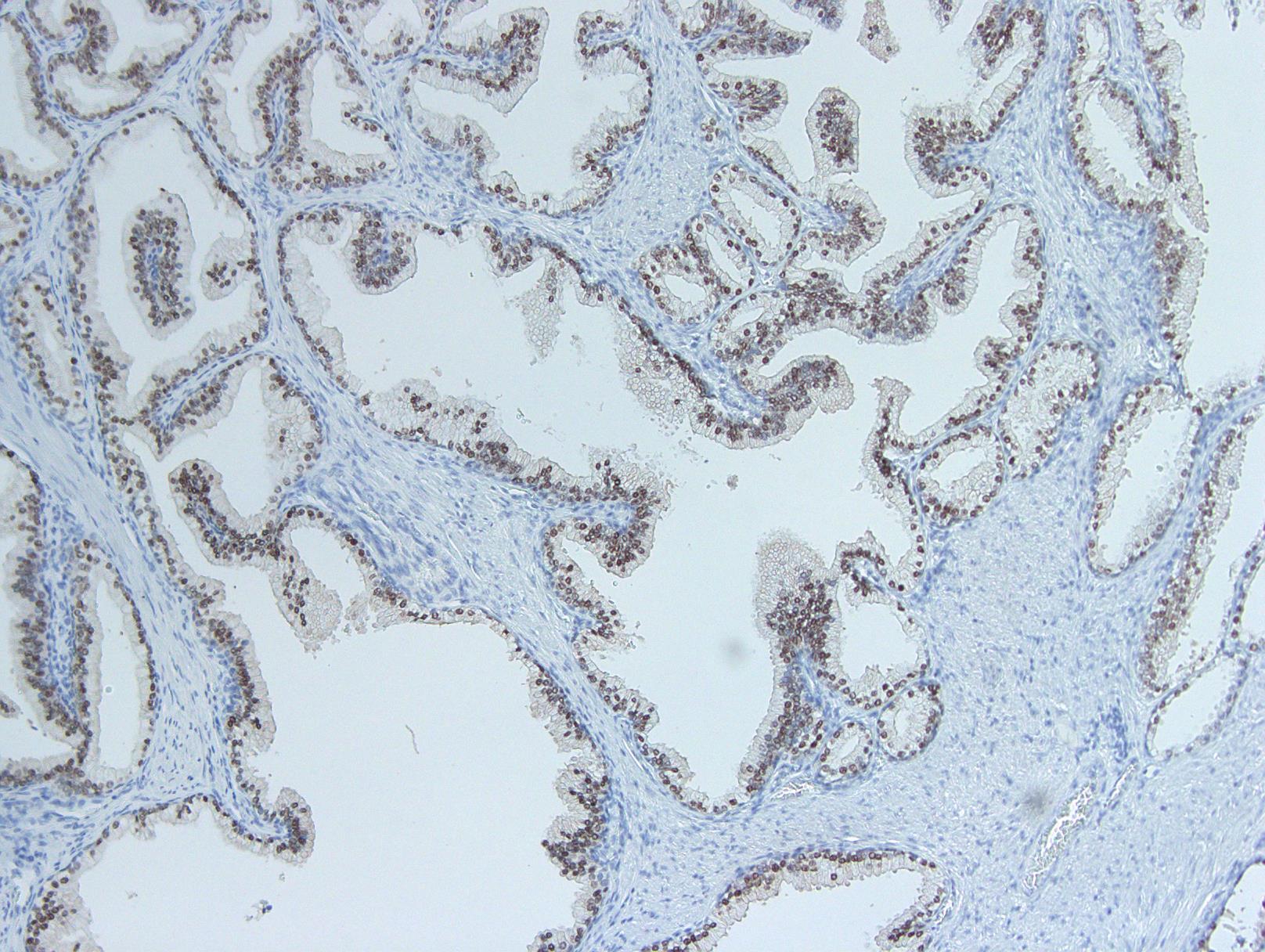Table of Contents
Definition / general | Essential features | Terminology | Pathophysiology | Interpretation | Uses by pathologists | Microscopic (histologic) images | Positive staining - normal | Positive staining - disease | Negative staining | Additional references | Practice question #1 | Practice answer #1Cite this page: Thakur S, Enwere E. NKX3.1. PathologyOutlines.com website. https://www.pathologyoutlines.com/topic/stainsnkx3.html. Accessed September 24th, 2025.
Definition / general
- NKX3.1 is a 234 amino acid transcription factor protein that is expressed in the prostate
- Important in development of prostate epithelium and ducts
- Expression is regulated in an androgen specific manner
Essential features
- NKX3.1 can generally be used as a diagnostic biomarker for prostate cancer and other metastatic lesions originating in the prostate
- Reduction in NKX3.1 expression is commonly reported in human prostate carcinomas and prostatic intraepithelial neoplasia (PIN) due to allelic loss, promoter methylation and posttranscriptional silencing (Differentiation 2008;76:717)
- The human NKX3.1 gene is located on chromosome 8p21, which undergoes loss of heterozygosity (LOH) with increasing frequency during the progression of prostate cancer
Terminology
- NK3 homeobox 1
- Homeobox protein NK3 homolog A
- NKX3.1
- NKX3A
- NK3 transcription factor related, locus 1 (Drosophila)
- NK3 transcription factor related, locus 1
- NK homeobox (Drosophila), family 3, A
- NK3 transcription factor homolog A
- NK homeobox, family 3, A
- Homeobox protein NKX-3.1
- BAPX2
- NKX3
- Reference: GeneCards: NKX3-1 Gene [Accessed 24 February 2021]
Pathophysiology
- NKX3.1 gene encodes a transcription factor of the homeobox family
- During prostate development, NKX3.1 is expressed in an androgen dependent manner and regulates the formation of prostatic epithelium and ducts (Int J Stem Cells 2021;14:168)
- While NKX3.1 is not a tumor suppressor gene per se, experimental and clinical evidence strongly associates it with the development and progression of prostate cancer:
- Large genome wide association studies have identified NKX3.1 as a prostate cancer susceptibility gene (Nat Genet 2009;41:1116, Nat Genet 2010;42:751)
- Deletion of 1 or both alleles of NKX3.1 in mice leads to the development of preinvasive lesions that resemble human PIN (Mol Cell Biol 2002;22:1495)
- The human NKX3.1 gene is located on chromosome 8p21, which undergoes LOH in 40% of prostatic adenocarcinomas (Cancer Cell 2010;18:11)
- The frequency at which NKX3.1 expression is reduced increases with progression from PIN to metastatic disease (Cancer Res 2000;60:6111)
- LOH of NKX3.1 in prostate cancer patients is associated with increased genetic instability and increased likelihood of relapse following treatment (Clin Cancer Res 2012;18:308)
- Loss of NKX3.1 sets the stage for accumulation of further oncogenic mutations in genes such as CDKN1B, TP53 and PTEN (Cell 2013;153:666)
- In mice with targeted disruption of PTEN or CDKN1B, loss of one or both alleles of NKX3.1 results in aggressive prostate tumorigenesis (Cancer Res 2003;63:3886, Am J Pathol 2004;164:1607)
- In mice, a lineage of castration resistant, NKX3.1 expressing cells are stem cells capable of initiating prostate cancer (Nature 2009;461:495)
Interpretation
- Nuclear stain (GeneCards: NKX3-1 Gene [Accessed 24 February 2021])
Uses by pathologists
- NKX3.1 has traditionally been used as a diagnostic biomarker for prostate cancer and other metastatic lesions originating in the prostate (Am J Surg Pathol 2014;38:e6, Adv Anat Pathol 2015;22:149)
- Gyn: can help identify ectopic prostatic metaplasia in gynecological lesions, including adenoid basal cell carcinoma of the cervix, ovarian teratoma and vaginal tubulosquamous polyps (see also use with Skene gland derivatives below) (Am J Surg Pathol 2020;44:1040, Pathology 2021;53:193, Int J Surg Pathol 2021;29:510)
- GU: determine origin of prostate lesions mimicking urothelial carcinoma (Appl Immunohistochem Mol Morphol 2019;27:523)
Microscopic (histologic) images
Positive staining - normal
- Highly expressed in the prostate and at a lower level in the testis (GeneCards: NKX3-1 Gene [Accessed 24 February 2021], Prostate 2003;55:111)
- Salivary gland tissue; bronchial submucosal glands; isolated regions of transitional epithelium in the ureter
Positive staining - disease
- Prostatic adenocarcinoma (Prostate 2003;55:111, Am J Surg Pathol 2007;31:1246)
- There is some controversy with respect to the expression of NKX3.1 in EWSR1-NFATc2 fusion positive sarcoma and mesenchymal chondrosarcoma:
- 1 group demonstrated positive expression in both tumor types:
- EWSR1-NFATc2 sarcoma, 9/11 cases (82%); for mesenchymal chondrosarcoma, 12/12 cases (100%), using a rabbit polyclonal antibody (Athena) (Am J Surg Pathol 2020;44:719)
- The same group supported these findings in a separate study with further staining and RNA expression assays
- EWSR1-NFATc2 sarcoma, 3/3 cases (100%); for mesenchymal chondrosarcoma, 10/10 cases (100%), using a rabbit monoclonal antibody (clone EP356, Cell Marque) (Am J Surg Pathol 2021;45:578)
- A separate group demonstrated positive expression in mesenchymal chondrosarcoma: 9/12 cases (75%), using a rabbit monoclonal antibody (clone EP356, Cell Marque) (Pathology 2021;S0031)
- 2 other groups, however, were unable to reproduce these findings
- EWSR1-NFATc2 and FUS-NFATc2 sarcomas: 0/6 cases (0%), using a rabbit monoclonal antibody (clone EP356, Cell Marque) (Mod Pathol 2020;33:1930)
- Mesenchymal chondrosarcoma: 0/25 cases (0%), using both a rabbit polyclonal antibody (Athena) and a rabbit monoclonal antibody (clone EP356, Cell Marque) (Histopathology 2021;78:334)
- The use of NKX3.1 staining in characterization of these tumor types should be applied with caution and ideally with excellent immunohistochemical controls
- 1 group demonstrated positive expression in both tumor types:
- May be expressed in Skene gland derivative tumors of the female urethra, such as adenoid basal carcinoma (Am J Surg Pathol 2018;42:1513, Int J Gynecol Pathol 2021;40:400)
- Reports of expression in salivary duct carcinoma:
- Variable staining, 15/42 cases (35.7%), using a mouse monoclonal antibody (A02709, Boster Biological) (Pathobiology 2020;87:30)
- Focal staining, 3/23 cases (13%), using a rabbit monoclonal antibody (EP356, Cell Marque) (Hum Pathol 2019;84:173)
- Testicular Sertoli cell tumors (1/4, 25% of cases) (Am J Surg Pathol 2020;44:61)
- Sertoli component of ovarian Sertoli-Leydig cell tumors (1/12, 8% of cases) (Am J Surg Pathol 2020;44:61)
- May be seen in invasive lobular breast carcinoma (27%), metastatic lobular breast carcinoma (25%), invasive ductal breast carcinoma (2 - 9%) and metastatic ductal breast carcinoma (5%) (J Clin Pathol 2014;67:768, Prostate 2003;55:111)
- Primary adenocarcinoma of the trachea of presumptively mucinous origin (Pathol Res Pract 2018;214:796)
Negative staining
- Basal cell carcinoma of the prostate (JCO Precis Oncol 2018;2, Case Rep Pathol 2021;2021:5520581)
- EWSR1-NFATc2 rearranged simple bone cysts, as compared to the reports of positive staining in EWSR1-NFATc2 sarcoma described above (Am J Surg Pathol 2021 Jun 3 [Epub ahead of print])
- Seminal vesicles (Ann Diagn Pathol 2020;49:151644)
- Ovarian Sertoli cell tumors (0/3 cases) (Am J Surg Pathol 2020;44:61)
- Testicular embryonal carcinoma and seminoma (Am J Pathol 2003;163:2149, Am J Surg Pathol 2020;44:61)
- Rete testis adenocarcinoma (Am J Surg Pathol 2019;43:670)
- Solitary fibrous tumors of the prostate (< 5% staining in 1/4 cases) (Pathology 2020;52:643)
- Extramammary Paget disease of the scrotum (Appl Immunohistochem Mol Morphol 2020;28:524)
- Nephrogenic adenoma (Histopathology 2017;71:669)
Additional references
Practice question #1
Which of the following would be expected to exhibit the weakest staining for NKX3.1?
- Bladder adenocarcinoma
- Normal prostatic epithelium
- Primary prostate adenocarcinoma
- Prostate carcinoma nodal metastasis
- Prostatic intraepithelial neoplasia (PIN)
Practice answer #1
A. Bladder adenocarcinoma. NKX3.1 staining is typically limited to prostate (benign and malignant) and some breast carcinomas.
Comment Here
Reference: NKX3.1
Comment Here
Reference: NKX3.1



